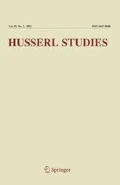Notes
I apologize if I have failed to take account of any other relevant writings of AS wherein he has explicitly undertaken the eidetics of verticality. He mentions (pp. 12–14) but does not use the discussions in Bachelard, Erwin Straus, and Merleau-Ponty. Discussions by Husserl and Heidegger of the earthly and heavenly are only obliquely alluded to. I would note that Conrad-Martius explored this theme. Mircea Eliade, the historian and philosopher of religion had much to say about the “ascension” and “resurrection” motifs in the religions of the world as ciphers for our being in the world. The literature on this theme is abundant, but I especially recommend a remarkable discussion by an early student of Husserl, Hans Voss (Voss 1940). My point is not that AS does not show familiarity with literature that I think is important, but rather that this wonderful central theme of his book is simply not given the robust display it merits.
A philosopher who mightily wrestled with these matters and around whom controversy gathered was Maurice Blondel. In Protestantism, the issue surfaced with eighteenth and nineteenth century liberal theology and in the twentieth century with Karl Barth’s concerns regarding existential-hermeneutical-“natural” theology. For a magisterial discussion, albeit one attuned primarily to Catholic theology, see Aubert (1952).
In the wake of Sydney Shoemaker, H.-N. Castañeda, et alii we may say that we are non-ascriptively, non-identifyingly aware of ourselves in non-reflective self-awareness as well as in the use of the indexical “I.” Ceteris paribus something analogous may be said for our knowing of Others, i.e., we know them too both non-ascriptively and ascriptively. What we refer non-ascriptively to—i.e., what we refer to without assigning properties and without making use of any third-personal non-indexical term—we may say is “present” non-sortally. Spaemann (1996) has made a good case for this aspect of “persons” in arguing that “person” is a non-sortal term. Thus we may hold that although persons might be identifiably the same in second- and third-personal reference because of identical ascriptions or sortal terms, what these apparent ontological twins refer to non-ascriptively, and first-personally experience when they experience themselves and one another, is an essential non-sortal unique essence and identity. For an extensive discussion of many of the phenomenological and theological-religious themes close to the heart of AS, see Hart (forthcoming).
AS refers to Dan Zahavi’s claim, that for the rudimentary sense of self at the pre-reflexive level there is “no explicit awareness of the experience being mine” (p. 173ff.). At the pre-reflexive or non-reflexive level there is no explicit awareness of anything as anything. But what is important in transcendental phenomenology is that at the level of explicit reflexive awareness there is a recognition that what we make present is precisely what was pre-reflexively or non-reflexively lived, i.e., that this is present as the same as what one lived or “experienced” first-personally prior to reflection. “Mineness” is a way of stating precisely this point, that the reflected-on and the reflecting belong to the same stream of consciousness. Mineness is thus always part of one’s self-experiencing. To absolutely eliminate it would seem to obliterate the kind of inter-personal relation AS wants to sustain between the infinite and finite persons. Yet AS is keen not only to eliminate the selfishness of the I, self, or person, but to say of the mystic experience, it is “not ‘mine,’ though there is an experience. Or again, the experience of ‘mineness’ is so transformed as to make it meaningless to speak of a self in this instance” (p. 176). But to eliminate “mineness” or first-personal experiencing obliterates any sense in which the Myself experientially, non-reflectively, first-personally, subsists in the divine essence, because a lived experience that is not first-personal is an Unding. Further, with the elimination of the “mineness” of AS, someone else rather than AS might just as well be subsisting in the divine essence and be “related” to, or subsisting in, the divine person.
References
Aubert, R. (1952). La probléme de l’act de foi. Louvain: E. Warny.
Hart, J. G. (forthcoming). Who one is: A transcendental-existential phenomenology, Books 1–2. Dordrecht: Springer.
Prufer, T. (1993). Recapitualations. The Catholic University of America: Washington DC.
Sokolowski, R. (1993). Eucharistic presence. Washington, DC: The Catholic University of America.
Sokolowski, R. (1995). The God of faith and reason. Washington, DC: The Catholic University of America.
Spaemann, R. (1996). Personen. Stuttgart: Klett-Cotta.
Voss, H. (1940). Transcendenz und Raumanschauung. Frankfurt am Main: Klostermann.
Author information
Authors and Affiliations
Corresponding author
Rights and permissions
About this article
Cite this article
Hart, J.G. Steinbock, Anthony J. Phenomenology and Mysticism: The Verticality of Religious Experience. Indiana Series in the Philosophy of Religion. Husserl Stud 25, 169–175 (2009). https://doi.org/10.1007/s10743-009-9056-8
Received:
Accepted:
Published:
Issue Date:
DOI: https://doi.org/10.1007/s10743-009-9056-8

